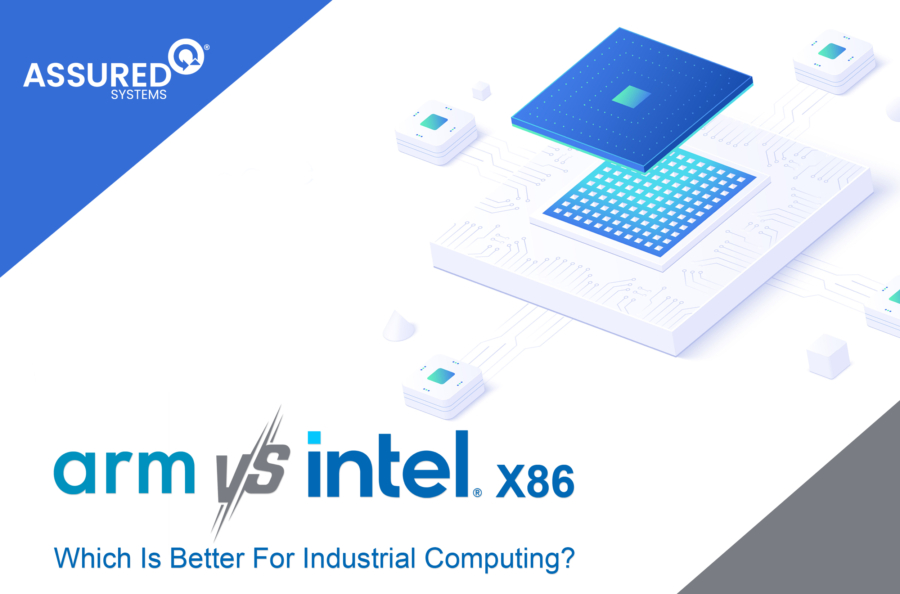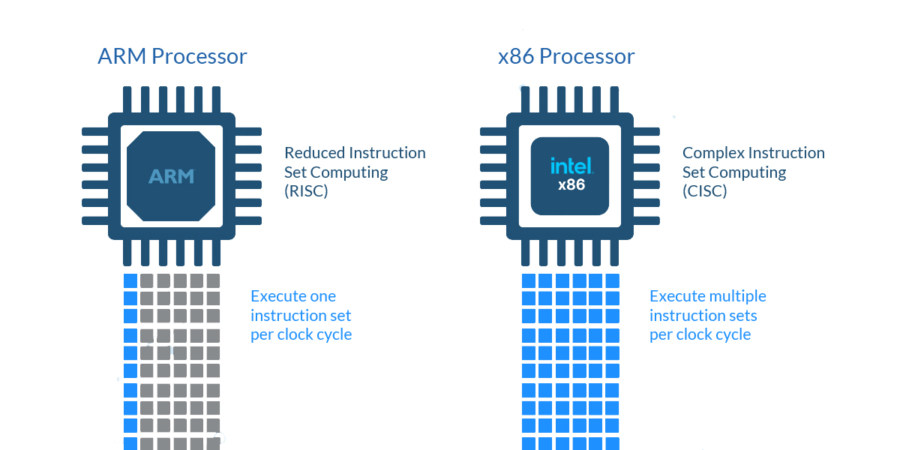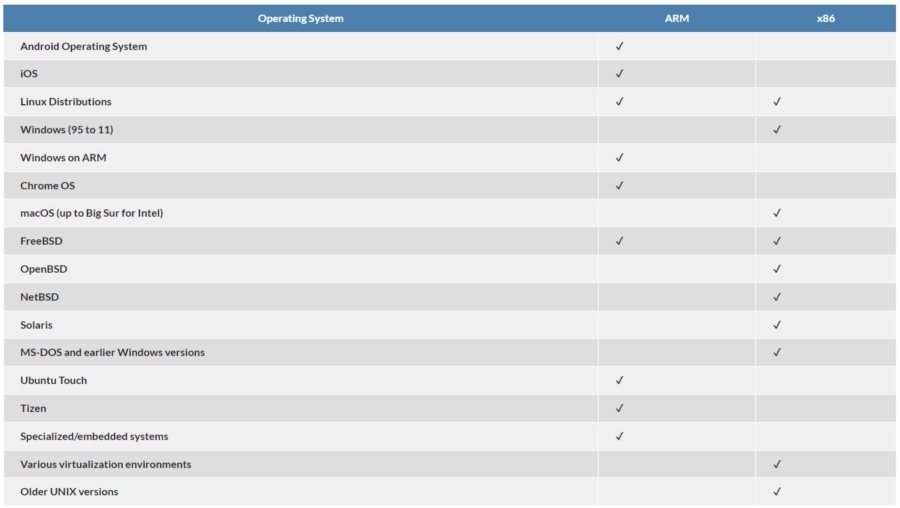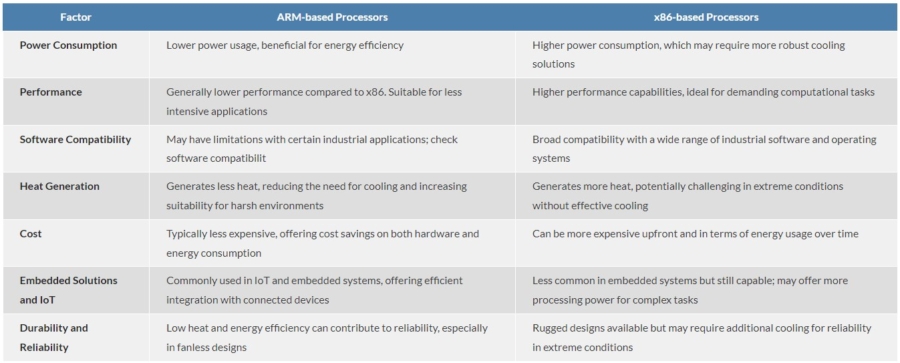In this article:
- ARM vs. x86: Exploring the Key Differences and Recent Advancements
- ARM vs. x86 Architecture: Key Distinctions and Performance Factors
- Choosing Between ARM and x86 Processors: The Crucial Role of Software Compatibility
- NVIDIA Jetson Orin Series: Revolutionising Edge Computing with ARM-Based Processors
- ARM-based vs x86-based: Which is better for rugged industrial computers?

ARM vs. x86: Exploring the Key Differences and Recent Advancements
The age-old comparison between ARM and x86 architectures has been revitalised by recent advancements in ARM technology, challenging longstanding benchmarks. Traditionally, ARM has excelled in power efficiency, dominating the mobile systems market, while x86 has been the frontrunner in high-performance computing. However, the landscape is evolving, with certain ARM configurations now surpassing x86 in performance, blurring the lines between historical distinctions and heralding a new era of computing power standards. This paradigm shift is reshaping industry narratives, propelling us towards a fresh era of architectural competition.
Before delving deeper into the comparison, it’s crucial to understand CPU architectures and instruction sets. The CPU serves as the central processing unit, responsible for executing instructions and performing calculations within a computer system. Each CPU possesses its own unique micro-architecture and belongs to a specific family, evolving over generations within product lines. ARM and x86 represent two prominent CPU instruction sets, serving as the foundation for the majority of smart devices and PC CPUs. While micro-architectures evolve rapidly, these instruction sets undergo less frequent changes, providing stability and compatibility across diverse computing platforms.

ARM vs. x86 Architecture: Key Distinctions and Performance Factors
The comparison between ARM and x86 processors reveals fundamental disparities across three pivotal areas: instruction sets, memory access methods, and core emphases. Let’s explore these variances and their implications in detail.
Instruction Sets: ARM processors employ a simplified approach known as RISC (Reduced Instruction Set Computing), prioritising energy efficiency and streamlined instruction execution. This design is particularly advantageous for battery-powered devices like smartphones, where quick and efficient processing is essential. In contrast, x86 architectures utilise a more intricate system called CISC (Complex Instruction Set Computing), capable of handling multiple tasks simultaneously. While this versatility enhances computational capabilities, it also adds complexity and cost to processor development.
Memory Access Methods: ARM processors focus on register-based processing, which limits direct memory access to enhance energy efficiency. On the other hand, x86 architectures offer more direct interaction with memory, enabling a broader range of computational tasks. However, this increased accessibility comes at the cost of higher power consumption, making x86 processors less suited for energy-conscious applications.

Programming Complexity: Programming for ARM processors typically requires more detailed commands due to their RISC architecture. This can present a learning curve for developers but ultimately contributes to optimised energy usage and efficient instruction execution. In contrast, x86 processors feature additional layers that assist in managing complex instructions, resulting in potentially larger executable files. While this complexity may offer advantages in handling intricate tasks, it also requires more computational resources.
Performance Considerations: ARM processors are commonly favoured for portable devices due to their energy-efficient design and streamlined instruction execution. In contrast, x86 architectures excel in powerful computers where computational prowess takes precedence over energy efficiency. Understanding these distinctions helps determine the most suitable architecture for specific application requirements, ensuring optimal performance and efficiency.
In summary, the contrasting characteristics of ARM and x86 architectures underscore their suitability for different computing environments. While ARM processors thrive in energy-conscious applications like portable devices, x86 architectures shine in high-performance computing scenarios. By leveraging their respective strengths, developers can tailor their choice of architecture to meet the unique demands of their projects, optimising, performance and energy efficiency.
Choosing Between ARM and x86 Processors: The Crucial Role of Software Compatibility
When deciding between ARM and x86 processors, software compatibility emerges as a critical consideration affecting both the operating system and the applications it runs. Operating systems tailored for x86 architecture are incompatible with ARM-based hardware, and vice versa. This discrepancy arises from the necessity for operating systems to communicate with hardware through a CPU-specific instruction set. Seamless compatibility between the operating system and processor architecture is vital for ensuring efficient system performance. Therefore, matching the hardware with the appropriate software ecosystem is essential to prevent compatibility issues and ensure smooth operation.
A comparison of supported operating systems for ARM and x86 architectures further illustrates this point:

Advantages and Disadvantages of ARM and x86
ARM Advantages:
- Lower power consumption: Ideal for mobile and battery-powered devices.
- Cost efficiency: Generally cheaper to produce due to simpler design.
- Heat efficiency: Generates less heat, reducing the need for cooling solutions.
- Market prevalence in mobile devices: Dominant in smartphones and tablets.
ARM Disadvantages:
- Lower performance at the same clock speed: Not ideal for high-end gaming or intensive computational tasks.
- Software compatibility: Limited native support for x86 applications without emulation or translation.
- Less variety in consumer desktop and laptop markets compared to x86.
x86 Advantages:
- High performance: Suitable for intensive computing tasks, including gaming, data analysis, and complex simulations.
- Extensive software ecosystem: Wide range of applications and operating systems developed for x86 architecture.
- Advanced features: Supports a broad range of computing features like hyper-threading, virtualisation, and complex instruction sets.
x86 Disadvantages:
- Higher power consumption: Requires more energy, making it less suited for battery-powered devices.
- Heat production: Generates more heat, often necessitating more sophisticated cooling systems.
- Cost: Typically more expensive to produce due to complexity and licensing fees.
Understanding the advantages and disadvantages of each architecture is essential for making informed decisions that align with specific project requirements and performance expectations.
NVIDIA Jetson Orin Series: Revolutionising Edge Computing with ARM-Based Processors
The emergence of ARM-based processors in edge computing heralds a transformative era in real-time data processing and analysis. A standout exemplar of this paradigm shift is the NVIDIA Jetson Orin Series, harnessing the power-efficient ARM architecture to deliver cutting-edge AI capabilities directly at the edge. These processors are meticulously crafted to tackle intricate computations locally, mitigating reliance on centralised data centres. Consequently, this approach enhances response times and curtails bandwidth demands.
The integration of ARM technology into the Jetson Orin Series underscores the escalating significance of amalgamating top-tier performance with energy efficiency in edge computing devices. This pivotal advancement paves the way for deploying intelligent, autonomous systems across diverse industries.
ARM-based vs x86-based: Which is better for rugged industrial computers?
The superiority of ARM-based processors over x86-based processors hinges on various factors unique to the industrial application and environment:











